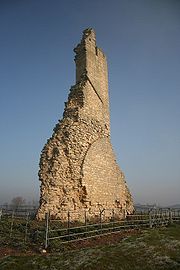
Kirkstead Abbey
Encyclopedia

Kirkstead
Kirkstead is an ancient village and former parish on the River Witham in Lincolnshire, England. It was amalgamated with the civil parish of Woodhall Spa in 1987.-History:...
, Lincolnshire
Lincolnshire
Lincolnshire is a county in the east of England. It borders Norfolk to the south east, Cambridgeshire to the south, Rutland to the south west, Leicestershire and Nottinghamshire to the west, South Yorkshire to the north west, and the East Riding of Yorkshire to the north. It also borders...
, England
England
England is a country that is part of the United Kingdom. It shares land borders with Scotland to the north and Wales to the west; the Irish Sea is to the north west, the Celtic Sea to the south west, with the North Sea to the east and the English Channel to the south separating it from continental...
.
The monastery was founded in 1139 by Hugh Brito, (or Hugh son of Eudo), lord of Tattershall
Tattershall
Tattershall is a village and civil parish in the East Lindsey district of Lincolnshire, England, located on the A153 Horncastle to Sleaford road, east of the point where that road crosses the River Witham. At its eastern end, Tattershall adjoins the village of Coningsby, to the north of the village...
, and was originally colonised by an abbot and twelve monks from Fountains Abbey
Fountains Abbey
Fountains Abbey is near to Aldfield, approximately two miles southwest of Ripon in North Yorkshire, England. It is a ruined Cistercian monastery, founded in 1132. Fountains Abbey is one of the largest and best preserved Cistercian houses in England. It is a Grade I listed building and owned by the...
in Yorkshire
Yorkshire
Yorkshire is a historic county of northern England and the largest in the United Kingdom. Because of its great size in comparison to other English counties, functions have been increasingly undertaken over time by its subdivisions, which have also been subject to periodic reform...
. The original site was not large enough however, and Robert, son of Hugh, found a better site a short distance away in 1187. It is worth noting here that the 1187 date is probably completion of the Abbey, as the architecture dates it to around 1175. The monks were granted the lordship of Wildmore
Wildmore
Wildmore is a civil parish in the East Lindsey district of Lincolnshire, England, located about north west of the town of Boston and about south of Horncastle....
by the lords of Bolingbroke, Scrivelsby and Horncastle, although they did retain the right of common pasture for themselves and their tenants.
The abbey remained in existence until 1537, when it was dissolved
Dissolution of the Monasteries
The Dissolution of the Monasteries, sometimes referred to as the Suppression of the Monasteries, was the set of administrative and legal processes between 1536 and 1541 by which Henry VIII disbanded monasteries, priories, convents and friaries in England, Wales and Ireland; appropriated their...
; the last abbot, Richard Harrison, and three of his monks were executed by Henry VIII
Henry VIII of England
Henry VIII was King of England from 21 April 1509 until his death. He was Lord, and later King, of Ireland, as well as continuing the nominal claim by the English monarchs to the Kingdom of France...
following their implication (probably unjustly) in the Lincolnshire Rising of the previous year.
The land passed to the Duke of Suffolk
Duke of Suffolk
Duke of Suffolk is a title that has been created three times in British history, all three times in the Peerage of England.The third creation of the dukedom of Suffolk was for Henry Grey, 3rd Marquess of Dorset, in 1551. The duke also held the title Baron Ferrers of Groby...
and later to the Clinton Earls of Lincoln, who built a large country house. By 1791 that too had gone and all that remains today is a dramatic crag of masonry - a fragment of the south transept wall of the abbey church - and the earthworks of the vast complex of buildings that once surrounded it, which is Grade I listed, and an ancient scheduled monument.
See also
- St. Leonard's WithoutSt. Leonard's WithoutThe church of St Leonard’s Without is a small and ancient chapel built between 1230 and 1240 in the parish of Kirkstead, Lincolnshire. It is an excellent example of the Early English style and even though measuring only by it is up to “Cathedral standards” of construction and may well have been...
(the 13th century chapel next to the abbey) - Woodhall SpaWoodhall SpaWoodhall Spa is a civil parish and village in the East Lindsey district of Lincolnshire, England within a wooded area on the Southern edge of the Lincolnshire Wolds, about south-west of Horncastle and about east-south-east of Lincoln...

